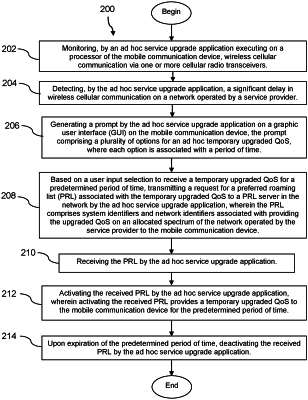| CPC H04W 28/0268 (2013.01) [H04L 47/286 (2013.01); H04L 67/75 (2022.05); H04W 8/02 (2013.01); H04W 24/08 (2013.01)] | 20 Claims |

|
1. A mobile communication device for receiving an ad hoc temporary upgrade in quality of service, comprising:
a processor;
at least one cellular radio transceiver;
a non-transitory memory; and
an ad hoc service upgrade application stored in the non-transitory memory that, when executed by the processor:
detects a delay in wireless cellular communication based on monitoring wireless cellular communication on a network operated by a service provider via the at least one cellular radio transceiver,
responsive to detection of the delay, generates a prompt on a graphic user interface (GUI) on the mobile communication device, the prompt comprising a plurality of options for an ad hoc temporary upgraded QoS, where each option is associated with a period of time,
based on a user input selection to receive a temporary upgraded QoS for a predetermined period of time, activates a preloaded preferred roaming list (PRL) associated with the temporary upgraded QoS, wherein activating the preloaded PRL provides the temporary upgraded QoS to the mobile communication device for a corresponding period of time, and
upon expiration of the corresponding period of time, deactivates the preloaded PRL.
|